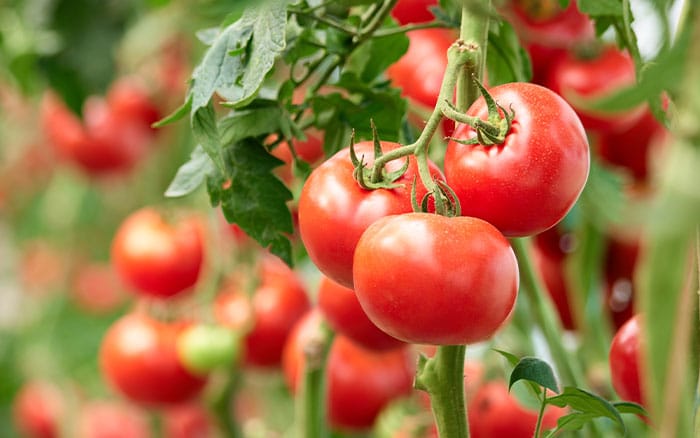Though we know a balanced diet is best, we don’t very often consider diversifying what we grow by colour. These quirky colours offer a smorgasbord of health advantages. So, spice up your supper with a splash of purples, reds, and oranges to enhance your health, and happiness.
1. Does colour mean quality?

Visual properties of food, including colour, provide cues when deciding what to eat. This is seen when we assess fruit for bruising and rot or check meat to protect against raw food. It’s an intuitive safety mechanism.
But research suggests that this relationship between food and colour may encourage us to eat healthier. As well as enjoying it more and deeming it a higher quality, the colour of our food can influence the perceived flavour. For example, richer colours taste seemingly sweeter to us.
Our overall experience of eating food is heightened when it’s more pleasing to look at. Therefore, it’s suggested that visually appealing fresh food might benefit our health by encouraging us to eat more of it.
So, a veggie plot that’s bursting with colour might well boost your health by naturally offering a diverse food range.
2. Colours found in nature
The colour of our food is determined by which pigments are present. Anthocyanins are pigments found in naturally blue, red, and purple foods, like berries. And studies have just begun to examine how these may protect against ailments like cancer and cardiovascular diseases.
However, whilst the jury’s out, the ‘brighter is better’ rule might still apply. But for different reasons. For instance, carotenoids are pigments which have their own cosmetic uses. These are namely yellow, orange, and when consumed, they’re used by animals to produce bright displays, like the pink-feathered flamingo. No members of the animal kingdom can synthesize carotenoids, so instead gain them from their diet.

The red-coloured carotenoid, lycopene, found in tomato fruit can even deliver a carotenoid kick to your diet in the form of tomato sauce. A 2017 study by the University of Western Australia found that a higher intake of carotenoids increased the perceived attractiveness and health of participants.
So, if you’re after a shining complexion, steer towards purple carrots. They are said to contain twice as much alpha and beta carotene than their orange counterparts. Helpfully, cooking your carrots might increase the beta-carotene content. The heat breaks down plant cells to make the content more available. So, up your intake for that carotenoid-glow, by planting (Baby Chantenay) Cascade F1 before the end of July. These are succulent and sweet-tasting roots that will be ready to harvest by November.
3. Kids and creative colours

Colours are frequently used to engage kids with creative play, and you can tap into this in the garden too. Schools across the UK now have gardens onsite to get students learning about nature. And a report by The National Foundation for Educational Research suggests that this will develop fine motor skills and provide an opportunity for them to try healthy, fresh produce.
Try this at home by offering a blanket of colour for them to nurture. This may even get your kids more interested in food and eating their greens. Cornell University found children were more likely to eat their veggies when there were more than six colours on their plates.
You might find that your go-to growers are a bit one-sided. If you design your plot like a paint palette and grow for colour instead, you’ll find that your diet becomes well-rounded. According to research, pigmented potatoes have a significantly higher antioxidant potential than white potato varieties—so there’s nothing to lose!
4. Colour, mood and motivations
Certain colours can influence how we feel. And one study by J. L. Morton, in 2008, found that these associations may even influence our relationship with food. Shades of blue, for example, might suppress hunger since it’s not a colour associated with safe eating in the natural world.

Red colours may influence us to eat more and are often used in fast food environments. Soft hues may cause mindless eating and longer restaurant stays (Singh, 2006).
This phenomenon is also seen in the world of interior design. Certain colours can be used to design an aesthetic for ambience. So, when in the garden, don’t just look at the colour of the feature, but make focus on the greenery around you and design your own oasis. Many of us use garden time to unwind and our experiences in green spaces have taught us that such time can be liberating, and a way of connecting with nature.
A report by the mental health charity, Mind, which examines ‘Ecotherapy’, notes that approaches like taking notice of the world and enjoying green exercise are recognised methods of improving well-being.
5. Creating colourful garden designs

You can also take the opportunity to grow for expression, with your plot conveying colours which mean the most to you and reflect your intentions. Try a white potting shed to make those green shades really pop. Or paint your shed in a mural of colours that communicate your personality.
Clothing is a perfect example of how we use colour every day to convey emotions by choosing options which reflect the season, our mood, or our character. These colour choices then impact our interaction with others. And this same practice can be tapped into to enhance your gardening experience.
A rainbow of colour will cover all your health bases. Create a harvest which has a little bit of each, and you’ll create a colourful and creative space that provides an assorted array of applications for healthy living.

Leave A Comment